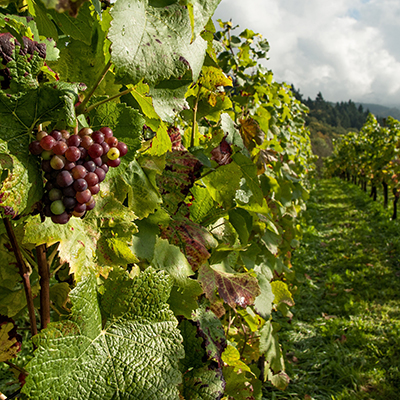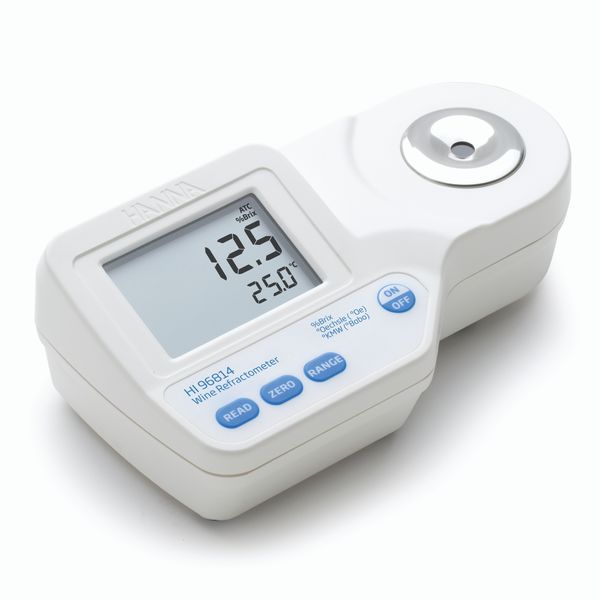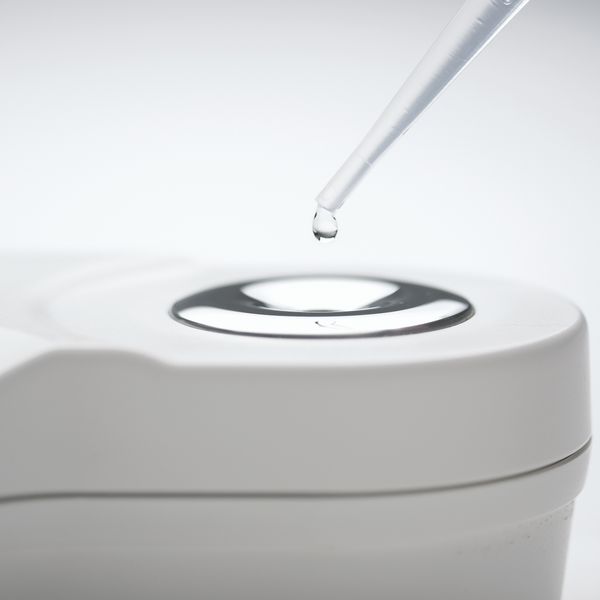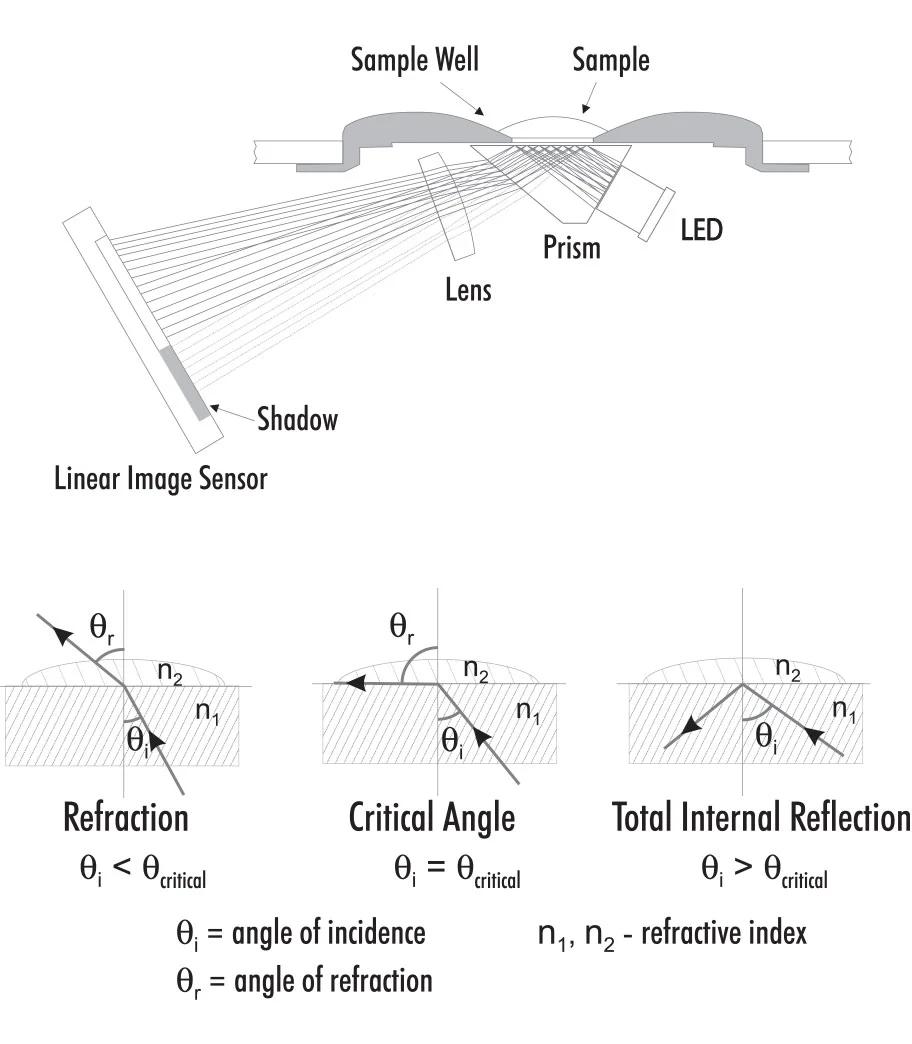Force and mechanical measuring equipment
– Measure sugar content (% Brix,°Oe and °KMW) in wine, jam and juice
– Accuracy ± 0.2% Brix, ± 1°Oe and ± 0.2°KMW
– Measured values are automatically compensated for temperature according to ICUMSA Methods Book standards
– Easy to use, quick and accurate measurement in just 1.5 seconds
– Small sample size requires only 2 drops of solution (100 μl)
– Stainless steel ring with premium optical prism made of flint glass

The HI96814 is a portable refractometer that converts the refractive index of wine, juice or sucrose samples to % mass units which means % Brix (°Brix). This conversion is based on the ICUMSA Methods Book (International Commission for Uniform Methods for the Analysis of Sugars) method for changes in refractive index with temperature in a percent by weight glucose solution. Since the majority of the sugar in grape juice is fructose and glucose rather than sucrose, the measurement is sometimes referred to as “Apparent Brix”. Grapes typically have a sugar content of 29-35% Brix or degrees Brix (°Bx). The HI96814 is easily used by winemakers to measure grape sugars in the field or in the laboratory.
In addition to the % Brix, the HI96814 also features two scales used in the wine industry: °Oechsle and °KMW.
°Oechsle (°Oe) is used mainly in the German, Swiss and Luxembourgish wine industry to measure the sugar content of fermenting wine. The °Oe scale is based on the specific gravity at 20°C ((SG (20/20)) and is the first 3 digits after the decimal point. A °Oe approximately equal to 0.2% Brix.
°Oe = [(SG(20/20)) – 1] x 1000
° Klosterneuburger Mostwaage (° KMW) is used mainly in the wine industry in Austria to measure sugar content of fermenting wine. °KMW is related to °Oe by the following equation:
°Oe = °KMW x [(0.022 x °KMW) + 4.54] , 1°KMW is equivalent to 1% Brix or 5°Oe. °KMW is also known as °Babo.
“Potential” or “potential” alcohol is an estimate of the alcohol content (% vol/vol) of the finished wine based on the conversion between sugar and alcohol. This conversion depends on many factors, such as grape variety, grape maturity, growing region, and fermentation efficiency and temperature.
The HI96814 is easy to use for wineries to measure sugar in grapes or fermenting wine, either in the field or in the laboratory.

Large display shows the sweetness value of the food sample along with the temperature of the sample below
1-POINT CALIBRATION
The device has a calibration function with distilled water or deionized water before measuring the sample.
AUTOMATIC TEMPERATURE COMPENSATION (ATC)
The machine has a temperature measuring function that will read the result as the exact temperature compensated sweetness value without any further calculations.

Easy to clean after measurement and corrosion resistant
SMALL SAMPLE SIZE
Sample requires only about 2 drops (100 μl)
DUST AND STEAM PROTECTION DESIGN
FAST MEASUREMENT TIME, EASY TO USE
Results time is only 1.5 seconds, ideal for analyzing fruit juice, honey, etc.

WHAT IS A REFRACTOMETER?
The HANNA refractometer is a method of measuring samples based on the refractive index of the sample. The refractive index is a measure of how light passes through a sample. Depending on the composition of the sample, light will refract and reflect differently. By measuring this with a linear image sensor, the refractive index of the sample can be evaluated and used to determine its physical properties such as concentration and density. In addition to the linear image sensor, the refractometer uses an LED light, prism and lens to make measurements.
Temperature fluctuations will affect the accuracy of the refractive index, so the use of temperature compensation is highly recommended for reliable results. The refractometer contains a built-in temperature sensor and is programmed with temperature compensation algorithms according to the ICUMSA Method Book for percent sucrose solutions.
To make a standard % Brix solution (sucrose):
To make a Brix solution, follow the steps below:
Note: The solution above 65% Brix should be stirred vigorously or shaken and heated in a water bath to 40oC. Remove the solution from the tank when the sucrose has dissolved and allow to cool before use.
Sample 25% Sucrose:
|
% Brix (g/100g) |
Sucrose (g) |
Water (g) |
Total (g) |
|---|---|---|---|
|
25 |
25.000 |
75.000 |
100.000 |

SPECIFICATIONS
|
The scale |
0 to 50% Brix; 0-230° Oechsle; 0-42° KMW; 0 to 80°C (32 to 176°F) |
|---|---|
|
Resolution |
0.1% Brix; 1° Oechsle; 0.1° KMW; 0.1°C (0.1°F) |
|
Accuracy |
±0.2% Brix; 1° Oechsle; ±0.2° KMW; ±0.3 °C (±0.5 °F) |
|
Temperature compensation |
automatic from 10 to 40°C (50 to 104°F) |
|
Measurement time |
about 1.5 seconds |
|
Minimum sample size |
100 μL |
|
Light source |
Yellow LED |
|
Sample compartment |
Stainless steel ring and glass prism |
|
Automatically turns off |
after 3 minutes of non-use |
|
Bark |
IP65 |
|
The battery |
9V |
|
Size |
192 x 102 x 67 mm |
|
Mass |
420 g |
|
Guarantee |
12 months |
|
Supply includes |
– Measuring machine HI96814 – Battery (in the device) - User manual – Machine quality certificate - Warranty – Machine box. |